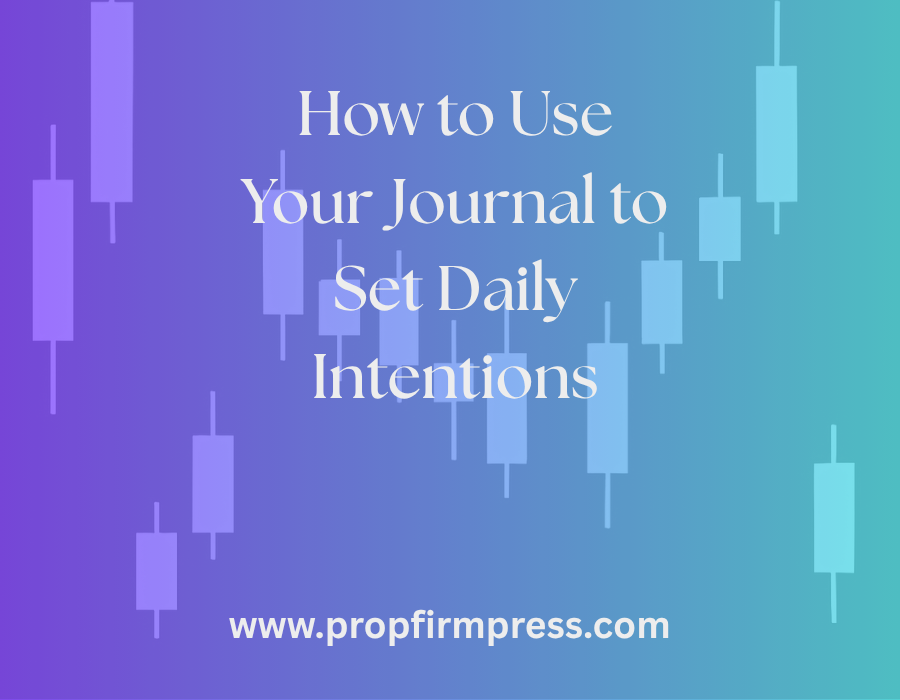Why Daily Intentions Matter for Prop Traders
In trading, intentions shape behavior. Without setting an intention for the day, you’re more likely to drift into emotional trades, violate rules, or chase opportunities that don’t align with your edge. For prop traders bound by strict rules and consistency metrics, even one undisciplined session can cause a reset or end your evaluation. That’s where journaling intentions becomes a game-changer. Writing a daily intention grounds your focus and establishes a mindset of control before the first trade is even placed. When you use your journal to set the tone for your session, you’re more likely to follow through on your trading plan, manage risk properly, and handle adversity with composure.
What Is a Daily Trading Intention?
A daily intention is not a goal like “Make $500.” It’s a behavioral anchor like “Trade only A+ setups” or “Follow my max trade limit.” It’s a specific mindset or action you want to embody throughout the session. These intentions align with your trading values, not your trading results. Unlike reactive journaling that happens after your session, intention setting is proactive. It tells your brain how to behave before real-money stress begins.
Benefits of Intention-Based Journaling
Here’s what setting intentions in your journal helps you achieve:
- Improved discipline: You’re less likely to improvise or break rules.
- Focus on process, not outcome: Detaches your emotions from your P&L.
- Stronger self-awareness: You reflect on your current mindset before acting.
- Increased consistency: You align each session with your long-term goals.
- Resilience under pressure: When volatility spikes or trades go red, you already have a calming narrative in place.
Using intention journaling is especially helpful during evaluations with firms like Instant Funding or Bright Funded, where violations can end your progress in minutes. Having an intention can pause emotional impulses and redirect you toward smarter action.
How to Write a Daily Intention
You don’t need to write a full paragraph. One or two sentences is enough. Your journal entry should follow this structure:
- Behavior: What specific action do you want to focus on?
- Mindset: What emotion or thought process do you want to maintain?
- Reminder: A phrase or quote to guide you during stress moments.
Sample journal intention entry:
“Today I will only take trades from my pre-planned watchlist. I will not force setups. If I lose two trades, I will stop for the day. I stay calm and trust the process.”
Pairing Intentions with Pre-Trade Checklists
Your intention is best written at the top of your daily journal page, followed by your pre-trade checklist. This helps bridge your mindset with your strategy. Checklists may include:
- Reviewed economic calendar
- Identified key support/resistance
- Confirmed A+ setups for the day
- Set daily max loss and trade count
The Prop Firm Press Journal Sheets include a Daily Intention section and checklist built into every trade log, so your mindset is visible before every entry.
Tracking Intentions Over Time
Use a weekly or monthly review to track which intentions helped your performance. For example:
- “Avoiding midday trades” led to higher win rates
- “Following trade cutoff rules” improved drawdown control
- “One setup per day” reduced overtrading and improved mental clarity
Track which intentions result in fewer violations or better outcomes, and consider adding them to your default trading rules. Over time, they become habits.
Using Intention Setting to Handle Emotional Days
When you’re feeling anxious, distracted, or frustrated, intention journaling is even more important. Writing a clear behavioral anchor resets your nervous system. Sample intentions for difficult days:
- “I will only observe today if I don’t feel calm.”
- “Today I will size down and trade slow.”
- “I will not let one trade define my day.”
Even if you skip trading, writing an intention helps you remain in your trader identity and keep your process consistent.
Affirmation Add-Ons for Extra Reinforcement
You can add affirmations beneath your intention to reinforce confidence. Sample affirmations:
- “I am a patient and disciplined trader.”
- “I protect my account before I grow it.”
- “I trade what I see, not what I want to see.”
These phrases may feel small, but repetition over time builds neural reinforcement that counteracts emotional impulses.
Case Study: Trader Using Intentions to Avoid Revenge Trading
One trader with Lucid Trading kept failing due to revenge trades. They began setting intentions every morning like, “If I take a red trade, I will pause for 15 minutes.” This was written in their journal each day. Over the next two weeks, they avoided four separate emotional trades—each of which would’ve hit the trailing drawdown. The difference wasn’t strategy—it was pre-commitment.
Building a Template for Intention-Based Journaling
If you prefer writing by hand, your daily page should look like this:
- Date:
- Morning intention:
- Checklist items completed:
- Trade plan focus:
- Affirmation:
- End-of-day reflection: Did I stay aligned with my intention?
All of these are built into the Daily Planner Sheets from Prop Firm Press to keep your behavior organized and consistent each morning.
Daily Intentions Make You More Than Just a Trader
They make you a professional. You stop reacting to markets and start preparing for them. You approach your desk with clarity, purpose, and emotional steadiness—everything a prop firm is looking for. Daily intention journaling might seem simple, but it builds the mental edge you need to pass faster, trade better, and stay funded longer.
